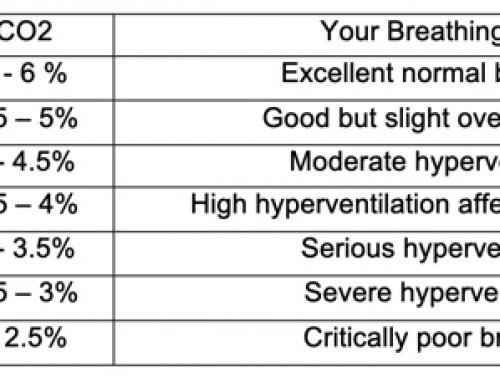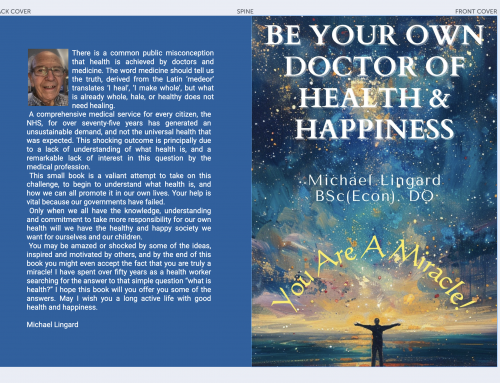Click on the image above if you would rather listen to this article.
Every parent has become increasingly aware of the need for good nutrition, good exercise, and a supportive home & school environment for the health and wellbeing of their children. The government campaigns have advised “Five a Day” and more sport in schools, but as yet there has been no recognition of the equally vital matter of good breathing for good health.
Poor breathing has been the hidden, silent factor responsible for many childhood health problems that can lay the foundation for a wide range of modern diseases in later life.
Here is another “Five a Day” recommendation to help your child:
1. Ensure your child is a good breather.
A simple test is the “Step exercise” Get your child to take a normal breath in then a normal breath out, then while they hold their nose see how many steps they can do, keeping their mouth closed before they need to release their nose to take another breath.
This is a simple measure of how well oxygenated their body is:
120 to 80 steps indicate excellent breathing
60 to 80 steps are very good
40 to 60 steps are good
30 to 40 steps are poor and will be impairing their health.
20 to 30 steps are very poor with an almost certain adverse effect on their health
Fewer than 20 steps is a dangerously low result and efforts should be made to correct this.
Older children may be able to measure their breathing with a “Control Pause”
Keeping their mouth closed, take a normal breath in then a normal breath out, and see how many seconds they can hold their nose for before taking another breath in. This exercise should be easy and stress-free, it is a measure of their maximum COMFORTABLE breath-hold.
45 to 60 seconds is excellent, 35 to 45 is very good, 25 to 35 is good, 20 to 25 is poor, 15 to 20 is very poor, 10 to 15 is seriously poor and under 10 suggests an urgent need to correct this.
Why not check your own breathing with a Control Pause as well? HERE
2. Help teach better breathing habits.
Encourage quiet nose breathing all the time. Set a good example by improving your own breathing!
3. Watch for signs of bad breathing habits.
The signs of poor breathing include mouth breathing, upper chest breathing, breathlessness, snoring at night.
Set a good example by being aware of your own breathing faults!
4. Encourage relaxation and quiet when stressed.
Teach quiet relaxation, breathing as gently as possible with all the body relaxed.
Set a good example by learning to relax yourself!
5. Tell them why they need a nose & how to make it work well.
The nose is for breathing & the mouth is for eating and talking.
“They should breathe through their mouth as often as they eat through their nose!”
Teach nose-clearing exercise: Breathe in then out through the nose, keep the mouth closed, hold the nose, gently nod the head until they need to breathe in, release the nose and take a breathe in. Repeat two or three times.
Check their progress from time to time with (1) above.
If your child, whatever age, mouth breathes rather than using the nose to breathe most of the time they could be heading for many health problems that could be easily avoided.
Children who habitually mouth-breathe will usually develop crooked, crowded teeth and fail to develop normal facial features.
They will be more at risk of developing asthma especially if there is a family history of asthma.
They will probably suffer more throat and chest infections than others simply because they are not using their first line of defense; nose breathing that kills most airborne bugs and aids the immune system.
As they get older and continue to mouth breathe they will begin to suffer the many health problems of chronic hidden hyperventilation, anxiety, panic attacks, hypertension, heart diseases, angina, hay fever, gastric problems, breathlessness, low energy, and the list goes on.
Finally, there is a strong connection between what we eat and how we breathe, so this additional “Five a Day” is going to help with the original “Five a Day” and any improvement in diet will lead to an improvement in breathing.
Don’t take our word for this, watch and hear a number of children from a Glasgow school who have trained this way, telling their own story on a video. HERE
All this is not new, the dangers of mouth breathing were brought to the attention of the medical profession over a hundred years ago in a book published, not by a doctor, but by an artist who recognized the problem while painting the indigenous population of the Americas. “Shut your mouth and save your life”.
Visit our website “Thebreathconnection.com” HERE to learn more about the health connections with our breathing, and if you want to understand the orthodontic relationship watch the video by Dr John Flutter, an Australian dentist HERE
Learn the Buteyko Method on Skype at any distance and at your convenience,
download pdf details HERE








Leave A Comment